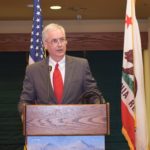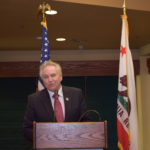The Complete story – February 24 Symposium
Recently, the Mountain Counties Water Resources Association (MCWRA) held a historic regional water symposium for its membership. While MCWRA has hosted many regional water programs in the past five years, never has MCWRA hosted a regional water symposium that included two United States Congressmen, three California State Senators, and one California Assembly Member under the same roof at the same time. Never has there been such a significant presence of county supervisors from the mountain counties area. It was a distinct honor and privilege that our representatives all attended to offer their views and perspectives on the regional and northern California water challenges and opportunities with the new Trump Administration.
Congressman Doug LaMalfa and Congressman Tom McClintock
Mavens Notebook captures the conversation
Here is the Video link for the morning session and that afternoon session where top regional water officials provide their views and perspectives
State Senator Jim Nielsen and State Senator Tom Berryhill
State Senator Ted Gaines and State Assembly Member Kevin Kiley
AFTERNOON PANEL
Left to right: Dave Eggerton, Calaveras County Water District, Marcus Yasutake, City of Folsom, Einar Maisch, Placer County Water Agency, Shannon Cotulla, South Tahoe Public Utility District, Brian Poulsen, El Dorado Irrigation District
REGIONAL WATER CHALLENGES AND OPPORTUNITIES
By: John Kingsbury, Executive Director, Mountain Counties Water Resources Association
Listening to our local, state and federal leaders at the all day symposium, caused me to reflect on many of the water issues that face water districts and their communities in the mountain counties area. Certainly, each issue in itself could make for a future opinion article,
- WATERSHED MANAGEMENT – Catastrophic wildland fires are a threat to water supply and downstream water quality. The overstocked forest and the dead, dying trees is unprecedented. There needs to be significant change in management of the state’s natural infrastructure if we are to sustain healthy forests and foothills, eco-systems, and high-quality water resources in California.
- WATER STORAGE – Much has been written and promoted about the need for more water storage, rightly so. This fresh water should be stored in northern California reservoirs, sequestered in the Sierra, and injected into the ground water basins to provide for multiple beneficial uses later.
- WATER QUALITY – Special interest groups want to squeeze valuable water resources from agriculture, and rural and urban communities so there is more fresh water to dilute the toxins in the river system. This should be considered a waste and an unreasonable use of water. The state should use Proposition 1 funding approved by the voters in 2014 and fix the water quality problems upstream.
- UNIMPAIRED FLOW – Special interest groups want more flow for fish in the Delta, yet ignore science and the other stressors in the Delta. To have a robust fishery, there needs to be ample food, cover, and cold water at the right time. More flow for the sake of flow is like trying to fill a bathtub with a hole in it.
- ALTERED DELTA – Decades of Delta alterations and sea level rise, demand more fresh water to fight mother nature and salt from intruding too far upstream. Adjustments must be made in the Delta. If sea rise is not properly addressed in the Delta, that additional demand for fresh water will come from northern California and the mountain counties tributaries.
- WATER RIGHTS AND LOCAL CONTROL – There is constant positioning to unravel historical water rights protections. These longstanding state assurances are paramount to this regions quality of life and should be honored unequivocally such that no state and/or federal agency exert regulatory authority to hinder or reallocate area-of-origin and/or watershed-of-origin water supplies that lays harm to the communities and eco-systems in the Mountain Counties Area.
- EMERGENCY DROUGHT – The drought is over. Yet, by keeping the “executive order emergency declaration” in play, regulators hold tight rein on power and authority, only to compound local water district challenges. Reduced revenue from rationing force water districts to raise water rates on communities and ratepayers that can’t afford it. Revenue that should go to replace and repair aging infrastructure goes to fund operating costs. The State is poised to establish permanent water rationing measures. The proposed measures will exasperate local community water issues.
- PUBLIC GOODS CHARGE – There is movement to impose what is being called a public goods charge on water. This will be a state mandate for water districts to impose a surcharge on your bill. That money should go to replace your water district’s aging infrastructure. My money says it goes to Sacramento never to return. This means, loss of local control and raised rates!
- WATER RATIONING – Water districts are required by Proposition 218 to charge their ratepayers the cost to provide service, which is what they do. Look for the state to change that to penalize water districts if they miss those water rationing targets the state hopes to impose, again, either legislatively or regulatorily. Once the indoor and outdoor household water use targets have been established, it will be easy for the regulators and legislature to get out the ratchet and raise those targets, becoming standards. This is a direct hit on water rights.
Regional water reliability should be of significant concern. Only by setting aside differences and working with our local, state, and federal representatives on comprehensive water management solutions will this region have any chance to achieve long-term water reliability for the foreseeable future.






